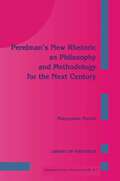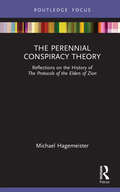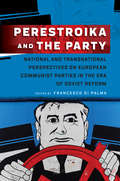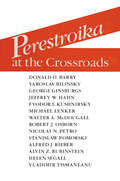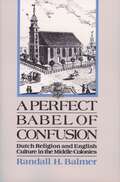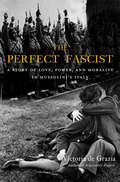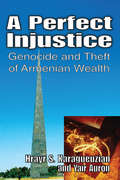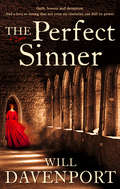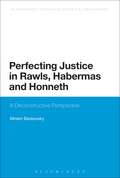- Table View
- List View
Perelman’s New Rhetoric as Philosophy and Methodology for the Next Century (Library of Rhetorics #1)
by M. ManeliBoth Perelman's collaborators, Professors Haarscher and Ingber, shared with me their deep personal insights about origins, birth and phases of the develop ment of the New Rhetoric. Without their good will, advice and creative com ments, my personal knowledge would have been narrower. I am grateful to the Chaim Perelman Foundation for their grant which enabled me to cover my expenses of collecting materials, editing and preparing the manuscript. Professor Michel Meyer was very instrumental in the negotiations with the publisher. Mr. Raphael Lipski, treasurer of the Perelman Foundation, spent many hours with me, and shared his remembrances of Perelman's personality, his social and political activity. lowe special thanks to Dr. Richard Kramer, whose friendship I cherish for a quarter of a century. He read and edited not only the entire text of the book, but he offered many critical remarks and constructive suggestions which helped me to revise my own ideas and to formulate them more clearly and precisely. The first critical reader and editor was as usual Mrs. Elizabeth Previti. Professor Elzbieta Ettinger-Chodakowska, MIT, read this entire manuscript and shared with me her impressions. lowe special gratitude to my dear friend, Mrs. Stephanie Silvers for her steady help and moral support. Needless to say, I am solely responsible for all the deficiencies of this book.
The Perennial Conspiracy Theory: Reflections on the History of the Protocols of the Elders of Zion (Routledge Studies in Fascism and the Far Right)
by Michael HagemeisterThe Perennial Conspiracy Theory is a collection of essays on The Protocols of the Elders of Zion, a fake document which has created a pernicious antisemitic conspiracy theory. The author analyses the murky origins of this notorious forgery and the contested claims of authorship. He explores the impact of the Protocols on various countries during the interwar years including Soviet Russia, the United Kingdom, France, Nazi Germany, and the United States. He also profiles figures closely associated with the dissemination of antisemitic conspiracy theories, such as Sergei Nilus and Leslie Fry, as well as examining the controversies arising from the famous Bern trial related to the Protocols. The book concludes with an assessment of the ongoing influence of the Protocols in post-Soviet Russia. This volume will be of interest to researchers and students working in the fields of antisemitism, conspiracy theories, the far right, Jewish studies, and modern history.
The Perennial Conspiracy Theory: Reflections on the History of the Protocols of the Elders of Zion (Routledge Studies in Fascism and the Far Right)
by Michael HagemeisterThe Perennial Conspiracy Theory is a collection of essays on The Protocols of the Elders of Zion, a fake document which has created a pernicious antisemitic conspiracy theory. The author analyses the murky origins of this notorious forgery and the contested claims of authorship. He explores the impact of the Protocols on various countries during the interwar years including Soviet Russia, the United Kingdom, France, Nazi Germany, and the United States. He also profiles figures closely associated with the dissemination of antisemitic conspiracy theories, such as Sergei Nilus and Leslie Fry, as well as examining the controversies arising from the famous Bern trial related to the Protocols. The book concludes with an assessment of the ongoing influence of the Protocols in post-Soviet Russia. This volume will be of interest to researchers and students working in the fields of antisemitism, conspiracy theories, the far right, Jewish studies, and modern history.
The Perennial Struggle
by Michael LemayThe Perennial Struggle integrates the richness of insight the various social science perspectives offer to the study of ethnic and racial relations into a consistent viewpoint. The Perennial Struggle is about race, ethnic, and minority group relations and how they interact in group politics in the United States. Understanding these relationships is critical to understanding American society in general and American politics in particular. The United States is a nation of nations; it receives more immigrants to its shores by far than does any other nation of the world. The authors wrote this book to integrate the various perspectives of the social science disciplines into courses such as Race and Racism, Roots of American Racism, and Minority Group Politics in the United States. If American society is to avoid the woes of a Darfur, Bosnia, Kosovo, Northern Ireland, or Rwanda, or even to prevent the development of separatist movements as in French-speaking Canada, we need to better understand the perennial struggle of ethnic relations and its impact on politics and policy. We need to understand the history, contribution, and special problems of particular and often exemplary minority groups in American society. In short, we need to understand the how and the why of their perennial struggle.
The Perennial Struggle
by Michael LemayThe Perennial Struggle integrates the richness of insight the various social science perspectives offer to the study of ethnic and racial relations into a consistent viewpoint. The Perennial Struggle is about race, ethnic, and minority group relations and how they interact in group politics in the United States. Understanding these relationships is critical to understanding American society in general and American politics in particular. The United States is a nation of nations; it receives more immigrants to its shores by far than does any other nation of the world. The authors wrote this book to integrate the various perspectives of the social science disciplines into courses such as Race and Racism, Roots of American Racism, and Minority Group Politics in the United States. If American society is to avoid the woes of a Darfur, Bosnia, Kosovo, Northern Ireland, or Rwanda, or even to prevent the development of separatist movements as in French-speaking Canada, we need to better understand the perennial struggle of ethnic relations and its impact on politics and policy. We need to understand the history, contribution, and special problems of particular and often exemplary minority groups in American society. In short, we need to understand the how and the why of their perennial struggle.
Perestroika and the Party: National and Transnational Perspectives on European Communist Parties in the Era of Soviet Reform
by Francesco Di PalmaCountless studies have assessed the dramatic reforms of Mikhail Gorbachev, but their analysis of the impact on European communism has focused overwhelmingly on the Soviet Union and Eastern bloc nations. This ambitious collection takes a much broader view, reconstructing and evaluating the historical trajectories of glasnost and perestroika on both sides of the Iron Curtain. Moving beyond domestic politics and foreign relations narrowly defined, the research gathered here constitutes a transnational survey of these reforms’ collective impact, showing how they were variably received and implemented, and how they shaped the prospects for “proletarian internationalism” in diverse political contexts.
Perestroika and the Party: National and Transnational Perspectives on European Communist Parties in the Era of Soviet Reform
by Francesco Di PalmaCountless studies have assessed the dramatic reforms of Mikhail Gorbachev, but their analysis of the impact on European communism has focused overwhelmingly on the Soviet Union and Eastern bloc nations. This ambitious collection takes a much broader view, reconstructing and evaluating the historical trajectories of glasnost and perestroika on both sides of the Iron Curtain. Moving beyond domestic politics and foreign relations narrowly defined, the research gathered here constitutes a transnational survey of these reforms’ collective impact, showing how they were variably received and implemented, and how they shaped the prospects for “proletarian internationalism” in diverse political contexts.
Perestroika and the Party: National and Transnational Perspectives on European Communist Parties in the Era of Soviet Reform
by Francesco Di PalmaCountless studies have assessed the dramatic reforms of Mikhail Gorbachev, but their analysis of the impact on European communism has focused overwhelmingly on the Soviet Union and Eastern bloc nations. This ambitious collection takes a much broader view, reconstructing and evaluating the historical trajectories of glasnost and perestroika on both sides of the Iron Curtain. Moving beyond domestic politics and foreign relations narrowly defined, the research gathered here constitutes a transnational survey of these reforms’ collective impact, showing how they were variably received and implemented, and how they shaped the prospects for “proletarian internationalism” in diverse political contexts.
Perestroika at the Crossroads
by Alfred J. Rieber Alvin Z. RubinsteinThe contributors to this volume have undertaken an assessment of the Soviet Union as it enters the last decade of the 20th century. Organized to cover each major area of policy initiative (or response), the collection surveys the Gorbachev reform agenda and its successes and failures to date in various fields, including culture, economics, ideology, law, politics, federalism and the nationality problem, and foreign policy vis-a-vis the West, Eastern Europe and the Third World.
Perestroika at the Crossroads
by Alfred J. Rieber Alvin Z. RubinsteinThe contributors to this volume have undertaken an assessment of the Soviet Union as it enters the last decade of the 20th century. Organized to cover each major area of policy initiative (or response), the collection surveys the Gorbachev reform agenda and its successes and failures to date in various fields, including culture, economics, ideology, law, politics, federalism and the nationality problem, and foreign policy vis-a-vis the West, Eastern Europe and the Third World.
Perestroika Era Politics: The New Soviet Legislature and Gorbachev's Political Reforms
by Robert T. Huber Larry D KelleyThis book is an evaluation of the new legislative politics in the Soviet Union. The contributors examine the uneven progress of electoral and constitutional reform, the composition, organisation, staffing and procedures of the Congress of People's Deputies and the Supreme Soviet, the development of factions, movements and parties on the left, on the right, and of the nationalist bent, the path of executive-legislative relations and case studies of the role of the legislature on domestic and foreign policy realms. This book should prove of interest to students of Soviet politics, political parties, and legislative politics, as well as for anyone interested in the struggle of political ideas, forces, and institutions in the USSR today.
Perestroika Era Politics: The New Soviet Legislature and Gorbachev's Political Reforms (Contemporary Soviet - Post-soviet Politics Ser.)
by Robert T. Huber Larry D KelleyThis book is an evaluation of the new legislative politics in the Soviet Union. The contributors examine the uneven progress of electoral and constitutional reform, the composition, organisation, staffing and procedures of the Congress of People's Deputies and the Supreme Soviet, the development of factions, movements and parties on the left, on the right, and of the nationalist bent, the path of executive-legislative relations and case studies of the role of the legislature on domestic and foreign policy realms. This book should prove of interest to students of Soviet politics, political parties, and legislative politics, as well as for anyone interested in the struggle of political ideas, forces, and institutions in the USSR today.
Perestroika in the Countryside: Agricultural Reform in the Gorbachev Era
by William MoskoffThis book is a collection of seven papers originally given at the 1989 meetings of the American Association for the Advancement of Slavic Studies. The authors come from the fields of economics, history, and political science and are all specialists in the field of Soviet and East European agriculture. The first essay, by David Macey, assesses Gorbachev's agricultural reform in light of the experience of the Stolypin reforms at the beginning of the century. The essays by Jim Butterfield and Ed Cook examine the impediments to successful reform from the perspective of a political scientist and an economist. Karen Brooks and Don Van Atta concentrate their attention on the efforts to introduce lease contracting into agriculture. D.Gale Johnson's essay examines the economic effects of trade liberalization in agriculture. The final paper, by Michael Marrese, suggests that there are lessons for the Soviet Union to be learned from the Hungarian experience, namely, that the changes in agriculture must be comprehensive and that the party can win over popular support if its agricultural policies succeed.
Perestroika in the Countryside: Agricultural Reform in the Gorbachev Era
by William MoskoffThis book is a collection of seven papers originally given at the 1989 meetings of the American Association for the Advancement of Slavic Studies. The authors come from the fields of economics, history, and political science and are all specialists in the field of Soviet and East European agriculture. The first essay, by David Macey, assesses Gorbachev's agricultural reform in light of the experience of the Stolypin reforms at the beginning of the century. The essays by Jim Butterfield and Ed Cook examine the impediments to successful reform from the perspective of a political scientist and an economist. Karen Brooks and Don Van Atta concentrate their attention on the efforts to introduce lease contracting into agriculture. D.Gale Johnson's essay examines the economic effects of trade liberalization in agriculture. The final paper, by Michael Marrese, suggests that there are lessons for the Soviet Union to be learned from the Hungarian experience, namely, that the changes in agriculture must be comprehensive and that the party can win over popular support if its agricultural policies succeed.
A Perfect Babel Of Confusion: Dutch Religion And English Culture In The Middle Colonies
by Randall BalmerThe Perfect Fascist: A Story of Love, Power, and Morality in Mussolini’s Italy
by Victoria De GraziaThrough the story of one exemplary fascist—a war hero turned commander of Mussolini’s Black Shirts—the award-winning author of How Fascism Ruled Women reveals how the personal became political in the fascist quest for manhood and power. When Attilio Teruzzi, Mussolini’s handsome political enforcer, married a striking young American opera star, his good fortune seemed settled. The wedding was a carefully stage-managed affair, capped with a blessing by Mussolini himself. Yet only three years later, after being promoted to commander of the Black Shirts, Teruzzi renounced his wife. In fascist Italy, a Catholic country with no divorce law, he could only dissolve the marriage by filing for an annulment through the medieval procedures of the Church Court. The proceedings took an ominous turn when Mussolini joined Hitler: Lilliana Teruzzi was Jewish, and fascist Italy would soon introduce its first race laws. The Perfect Fascist pivots from the intimate story of an inconvenient marriage—brilliantly reconstructed through family letters and court records—to a riveting account of Mussolini’s rise and fall. It invites us to see in the vain, loyal, lecherous, and impetuous Attilio Teruzzi, a decorated military officer with few scruples and a penchant for parades, an exemplar of fascism’s New Man. Why did he abruptly discard the woman he had so eagerly courted? And why, when the time came to find another partner, did he choose another Jewish woman as his would-be wife? In Victoria de Grazia’s engrossing account, we see him vacillating between the will of his Duce and the dictates of his heart. De Grazia’s landmark history captures the seductive appeal of fascism and shows us how, in his moral pieties and intimate betrayals, his violence and opportunism, Teruzzi is a forefather of the illiberal politicians of today.
The Perfect Fit: Creative Work in the Global Shoe Industry
by Claudio E. BenzecryThe Perfect Fit shows us how globalization works through the many people and places involved in making women’s shoes. We know a lot about how clothing and shoes are made cheaply, but very little about the process when they are made beautifully. In The Perfect Fit, Claudio E. Benzecry looks at the craft that goes into designing shoes for women in the US market, revealing that this creative process takes place on a global scale. Based on unprecedented behind-the-scenes access, The Perfect Fit offers an ethnographic window into the day-to-day life of designers, fit models, and technicians as they put together samples and prototypes, showing how expert work is a complement to and a necessary condition for factory exploitation. Benzecry looks at the decisions and constraints behind how shoes are designed and developed, from initial inspiration to the mundane work of making sure a size seven stays constant. In doing so, he also fosters an original understanding of how globalization works from the ground up. Drawing on five years of research in New York, China, and Brazil, The Perfect Fit reveals how creative decisions are made, the kinds of expertise involved, and the almost impossible task of keeping the global supply chain humming.
The Perfect Fit: Creative Work in the Global Shoe Industry
by Claudio E. BenzecryThe Perfect Fit shows us how globalization works through the many people and places involved in making women’s shoes. We know a lot about how clothing and shoes are made cheaply, but very little about the process when they are made beautifully. In The Perfect Fit, Claudio E. Benzecry looks at the craft that goes into designing shoes for women in the US market, revealing that this creative process takes place on a global scale. Based on unprecedented behind-the-scenes access, The Perfect Fit offers an ethnographic window into the day-to-day life of designers, fit models, and technicians as they put together samples and prototypes, showing how expert work is a complement to and a necessary condition for factory exploitation. Benzecry looks at the decisions and constraints behind how shoes are designed and developed, from initial inspiration to the mundane work of making sure a size seven stays constant. In doing so, he also fosters an original understanding of how globalization works from the ground up. Drawing on five years of research in New York, China, and Brazil, The Perfect Fit reveals how creative decisions are made, the kinds of expertise involved, and the almost impossible task of keeping the global supply chain humming.
A Perfect Injustice: Genocide and Theft of Armenian Wealth
by Yair AuronExcept for a short period after the end of the First World War and the ensuing armistice, Turkey has consistently denied that it ever employed a policy of intentional destruction of Armenians. Th e 1913-1914 census put the number of Armenians living in Turkey at close to two million. Today only a few thousand Armenians remain in the city Istanbul and none elsewhere in Turkey. Armenian sites in Turkey, including churches, have been neglected, desecrated, looted, destroyed, or requisitioned for other uses, while Armenian place names have been erased or changed. As with the Jewish Holocaust, Armenian properties that were seized or stolen have not been restored. Sixty and ninety years after these terrible events, Jewish and Armenian victims and their heirs continue to struggle to get their properties back. Th ere has been only partial restitution in the Jewish case and virtually no restitution at all in the Armenian case. No adequate reparation for the deeds committed against the Armenians can ever be made. But resolving claims with respect to stolen property is a symbolic gesture toward victims and their heirs. Th is is unfinished business for Jewish heirs and survivor of the Holocaust, as it is for Armenians. A Perfect Injustice is an essential contribution to understanding why the issue of stolen Armenian wealth remains unresolved after all these years--a topic addressed for the fi rst time in this volume.
A Perfect Injustice: Genocide and Theft of Armenian Wealth
by Yair AuronExcept for a short period after the end of the First World War and the ensuing armistice, Turkey has consistently denied that it ever employed a policy of intentional destruction of Armenians. Th e 1913-1914 census put the number of Armenians living in Turkey at close to two million. Today only a few thousand Armenians remain in the city Istanbul and none elsewhere in Turkey. Armenian sites in Turkey, including churches, have been neglected, desecrated, looted, destroyed, or requisitioned for other uses, while Armenian place names have been erased or changed. As with the Jewish Holocaust, Armenian properties that were seized or stolen have not been restored. Sixty and ninety years after these terrible events, Jewish and Armenian victims and their heirs continue to struggle to get their properties back. Th ere has been only partial restitution in the Jewish case and virtually no restitution at all in the Armenian case. No adequate reparation for the deeds committed against the Armenians can ever be made. But resolving claims with respect to stolen property is a symbolic gesture toward victims and their heirs. Th is is unfinished business for Jewish heirs and survivor of the Holocaust, as it is for Armenians. A Perfect Injustice is an essential contribution to understanding why the issue of stolen Armenian wealth remains unresolved after all these years--a topic addressed for the fi rst time in this volume.
The Perfect Police State: An Undercover Odyssey into China's Terrifying Surveillance Dystopia of the Future
by Geoffrey CainA riveting investigation into how a restive region of China became the site of a nightmare Orwellian social experiment—the definitive police state—and the global technology giants that made it possible Blocked from facts and truth, under constant surveillance, surrounded by a hostile alien police force: Xinjiang&’s Uyghur population has become cursed, oppressed, outcast. Most citizens cannot discern between enemy and friend. Social trust has been destroyed systematically. Friends betray each other, bosses snitch on employees, teachers expose their students, and children turn on their parents. Everyone is dependent on a government that nonetheless treats them with suspicion and contempt. Welcome to the Perfect Police State. Using the haunting story of one young woman&’s attempt to escape the vicious technological dystopia, his own reporting from Xinjiang, and extensive firsthand testimony from exiles, Geoffrey Cain reveals the extraordinary intrusiveness and power of the tech surveillance giants and the chilling implications for all our futures.
The Perfect Sinner
by Will DavenportDiscover a sumptuous and haunting novel of medieval loves, lies and loyalties.
The Perfect Tie (PDF): The True Story Of The 2000 Presidential Election
by James W. Ceaser Andrew E. BuschIn The Perfect Tie: The True Story of the 2000 Presidential Election, James W. Ceaser and Andrew E. Busch continue their study of national elections and their broader implications for American politics and society. With groundbreaking research of electoral politics and penetrating discussions of divided government, independent candidates, party platforms, realignment theory, the electoral college, and campaign strategies, Ceaser and Busch attempt to make sense of the 2000 presidential election. By separating myth from fact in presidential contests and by emphasizing the significance of frequently overlooked issues, such as foreign policy, this book is essential reading for courses in American Government, Campaigns and Elections, and Presidential Politics, as well as for any American interested in the real and lasting importance of the 2000 elections.
Perfecting Justice in Rawls, Habermas and Honneth: A Deconstructive Perspective (Continuum Studies in Political Philosophy)
by Miriam BankovskyIn this exciting new work, Miriam Bankovsky shows how the pursuit of justice requires two orientations. The first is a practical commitment to the possibility of justice, which is the clear starting point for the broadly constructive theories of Rawls, Habermas and Honneth. Indeed, if justice were not possible, it would be difficult to see why it is worthwhile for human beings to live on this earth. However, a second orientation qualifies the first. It can be expressed as a deconstructive attentiveness to the impossibility of determining justice's content. This impossibility results from the tension between the appeal for individual consideration and the appeal for impartiality, demands that Derrida believes our historical concept of justice includes. Framed by these two orientations, this ambitious book explores the promise and shortcomings of the constructive theories. Attentive to concrete experiences of injustice that these thinkers tend to overlook, Bankovsky provocatively challenges Rawls' account of civil disobedience, Habermas' defence of rational consensus, and Honneth's ideal of mutual recognition, providing new insights into deconstruction's relevance for contemporary theories of justice.
Perfection, the State, and Victorian Liberalism
by D. MalachukThis book recovers and recommends the core conviction of Victorian liberal theory that human beings, with the help of the state, can achieve an objective moral perfection. The first half of the book considers the diverse modern biases that have blinded us to the merit of this core conviction and weaves together disparate new scholarship (primarily in political theory and Victorian Studies) to set the stage for a reconsideration of that conviction. The second half of the book is that reconsideration outlining the various policies the Victorian liberals (John Stuart Mill and Matthew Arnold, primarily, with a half dozen other nineteenth-century British and American authors) recommended the state employ in the perfection of human beings.
